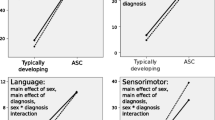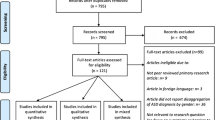Abstract
The existence of a female phenotype profile in autistic spectrum disorder is one of the current hypotheses to explain the diagnostic discrepancy between men and women. In this context, an international literature review was carried out to evidence and describe the characteristics of restricted interests found in girls with autistic spectrum disorder. A documentary search was conducted on PubMed and a systematic literature review was carried out based on the PRISMA methodology. We selected studies with a population of boys and girls diagnosed as autistic according to the DSM-IV or the DSM-5, in which quantitative and descriptive comparisons of restricted interests, according to gender were carried out. Nineteen studies were found to be relevant. Fifteen enabled a refining of the characteristics of restricted interests among females: fewer restricted interests were identified in comparison with boys, and the autistic girls’ interests seem to be closer to those of neurotypical girls than to those of autistic boys, which thus led to more complex screening. Age and Intelligence quotient seem to be two factors that trigger variations in restricted interests differently according to gender. Representations among professionals also have an impact on diagnoses among girls. For future research, one of the perspectives could be a comparison between girls with autism and neurotypical girls to limit gender bias. The present results contribute to potentially extending knowledge of a female phenotypical profile in autism and show the need to improve the general population’s awareness, to improve health professionals’ training and possibly to revise the diagnostic tools.

Similar content being viewed by others
Availability of data and material
Not applicable.
Code availability
Not applicable.
References
Fombonne E (2009) Epidemiology of pervasive developmental disorders. Pediatr Res 65:591–598. https://doi.org/10.1203/PDR.0b013e31819e7203
Fombonne E (1999) The epidemiology of autism: a review. Psychol Med 29:769–786. https://doi.org/10.1017/S0033291799008508
AP Association [APA] (2000) Diagnostic and Statistical Manual of Mental Disorders, 4th edn. APA, Washington, D.C.
American Psychiatric Association (2013) Diagnostic and Statistical Manual of Mental Disorders, 5th edn. APA, Washington, D.C.
DeLoache JS, Simcock G, Macari S (2007) Planes, trains, automobiles and tea sets: extremely intense interests in very young children. Dev Psychol 43:1579–1586. https://doi.org/10.1037/0012-1649.43.6.1579
Kim YS, Leventhal BL, Koh Y-J et al (2011) Prevalence of autism spectrum disorders in a total population sample. AJP 168:904–912. https://doi.org/10.1176/appi.ajp.2011.10101532
Mattila M-L, Kielinen M, Linna S-L et al (2011) Autism spectrum disorders according to DSM-IV-TR and comparison with DSM-5 draft criteria: an epidemiological study. J Am Acad Child Adolesc Psychiatry 50:583-592.e11. https://doi.org/10.1016/j.jaac.2011.04.001
Kopp S, Gillberg C (1992) Girls with social deficits and learning problems: Autism, atypical Asperger syndrome or a variant of these conditions. Eur Child Adolesc Psychiatry 1:89–99. https://doi.org/10.1007/BF02091791
Kirkovski M, Enticott PG, Fitzgerald PB (2013) A review of the role of female gender in ASD. J Autism Dev Disord 43:2584–2603. https://doi.org/10.1007/s10803-013-1811-1
Dean M, Harwood R, Kasari C (2016) The art of camouflage: Gender differences in the social behaviors of girls and boys with autism spectrum disorder. Autism 21:678–689. https://doi.org/10.1177/1362361316671845
Bargiela S, Steward R, Mandy W (2016) The experiences of late-diagnosed women with autism spectrum conditions: an investigation of the female autism phenotype. J Autism Dev Disord 46:3281–3294. https://doi.org/10.1007/s10803-016-2872-8
Young H, Oreve M-J, Speranza M (2018) Clinical characteristics and problems diagnosing autism spectrum disorder in girls. Arch Pediatr 25:399–403. https://doi.org/10.1016/j.arcped.2018.06.008
Van Wijngaarden-Cremers PJM, van Eeten E, Groen WB et al (2014) Gender and age differences in the core triad of impairments in autism spectrum disorders: a systematic review and meta-analysis. J Autism Dev Disord 44:627–635. https://doi.org/10.1007/s10803-013-1913-9
Allely C (2019) Exploring the female autism phenotype of repetitive behaviours and restricted interests (RBRIs): a systematic PRISMA review. Adv Autism 5:171–186. https://doi.org/10.1108/AIA-09-2018-0030
Leekam SR, Prior MR, Uljarevic M (2011) Restricted and repetitive behaviors in autism spectrum disorders: a review of research in the last decade. Psychol Bull 137:562–593. https://doi.org/10.1037/a0023341
Kreiser NL, White SW (2013) ASD in females: are we overstating the gender difference in diagnosis? Clin Child Fam Psychol Rev 17:67–84. https://doi.org/10.1007/s10567-013-0148-9
Lai M-C, Lombardo MV, Auyeung B et al (2015) Sex/gender differences and autism: setting the scene for future research. J Am Acad Child Adolesc Psychiatry 54:11–24. https://doi.org/10.1016/j.jaac.2014.10.003
PRISMA-P Group, Moher D, Shamseer L et al (2015) Preferred reporting items for systematic review and meta-analysis protocols (PRISMA-P) 2015 statement. Syst Rev 4:1. https://doi.org/10.1186/2046-4053-4-1
McFayden TC, Albright J, Muskett AE, Scarpa A (2018) Brief report: sex differences in asd diagnosis—a brief report on restricted interests and repetitive behaviors. J Autism Dev Disord 49:1693–1699. https://doi.org/10.1007/s10803-018-3838-9
Anthony LG, Kenworthy L, Yerys BE et al (2013) Interests in high-functioning autism are more intense, interfering, and idiosyncratic than those in neurotypical development. Dev Psychopathol 25:643–652. https://doi.org/10.1017/S0954579413000072
Nowell W, Jones DR, Harrop C (2018) Circumscribed interests in autism: are there sex differences? Adv Autism. https://doi.org/10.1108/AIA-09-2018-0032
Sutherland R, Hodge A, Bruck S et al (2017) Parent-reported differences between school-aged girls and boys on the autism spectrum. Autism 21:785–794. https://doi.org/10.1177/1362361316668653
Szatmari P, Liu X-Q, Goldberg J et al (2011) Sex differences in repetitive stereotyped behaviors in autism: implications for genetic liability. Am J Med Genet B Neuropsychiatr Genet 159B:5–12. https://doi.org/10.1002/ajmg.b.31238
Hiller RM, Young RL, Weber N (2014) Sex differences in autism spectrum disorder based on DSM-5 criteria: evidence from clinician and teacher reporting. J Abnorm Child Psychol 42:1381–1393. https://doi.org/10.1007/s10802-014-9881-x
Frazier TW, Georgiades S, Bishop SL, Hardan AY (2014) Behavioral and cognitive characteristics of females and males with autism in the Simons Simplex Collection. J Am Acad Child Adolesc Psychiatry 53(329–340):e1-3. https://doi.org/10.1016/j.jaac.2013.12.004
Fulceri F, Narzisi A, Apicella F et al (2015) Application of the Repetitive Behavior Scale-Revised – Italian version – in preschoolers with autism spectrum disorder. Res Dev Disabil 48:43–52. https://doi.org/10.1016/j.ridd.2015.10.015
Hiller RM, Young RL, Weber N (2015) Sex differences in pre-diagnosis concerns for children later diagnosed with autism spectrum disorder. Autism 20:75–84. https://doi.org/10.1177/1362361314568899
Frazier TW, Hardan AY (2016) Equivalence of symptom dimensions in females and males with autism. Autism 21:749–759. https://doi.org/10.1177/1362361316660066
Beggiato A, Peyre H, Maruani A et al (2016) Gender differences in autism spectrum disorders: divergence among specific core symptoms: gender differences in ASD. Autism Res 10:680–689. https://doi.org/10.1002/aur.1715
Antezana L, Factor RS, Condy EE et al (2018) Gender differences in restricted and repetitive behaviors and interests in youth with autism. Autism Res 12:274–283. https://doi.org/10.1002/aur.2049
Nicholas JS, Charles JM, Carpenter LA et al (2008) Prevalence and characteristics of children with autism-spectrum disorders. Ann Epidemiol 18:130–136. https://doi.org/10.1016/j.annepidem.2007.10.013
Wang S, Deng H, You C et al (2017) Sex differences in diagnosis and clinical phenotypes of Chinese children with autism spectrum disorder. Neurosci Bull 33:153–160. https://doi.org/10.1007/s12264-017-0102-9
Jamison R, Bishop SL, Huerta M, Halladay AK (2017) The clinician perspective on sex differences in autism spectrum disorders. Autism 21:772–784. https://doi.org/10.1177/1362361316681481
Knutsen J, Crossman M, Perrin J et al (2019) Sex differences in restricted repetitive behaviors and interests in children with autism spectrum disorder: an Autism Treatment Network study. Autism 23:858–868. https://doi.org/10.1177/1362361318786490
Mayes SD, Calhoun SL (2010) Impact of IQ, age, SES, gender, and race on autistic symptoms. Res Autism Spectrum Disord 5:749–757. https://doi.org/10.1016/j.rasd.2010.09.002
Solomon M, Miller M, Taylor SL et al (2011) Autism symptoms and internalizing psychopathology in girls and boys with autism spectrum disorders. J Autism Dev Disord 42:48–59. https://doi.org/10.1007/s10803-011-1215-z
Uljarević M, Cooper MN, Bebbington K et al (2020) Deconstructing the repetitive behaviour phenotype in autism spectrum disorder through a large population-based analysis. J Child Psychol Psychiatr. https://doi.org/10.1111/jcpp.13203
Seltzer MM, Shattuck P, Abbeduto L, Greenberg JS (2004) Trajectory of development in adolescents and adults with autism. Ment Retard Dev Disabil Res Rev 10:234–247. https://doi.org/10.1002/mrdd.20038
Gould J, Ashton-Smith J (2011) Missed diagnosis or misdiagnosis? Girls and women on the autism spectrum. Good Autism Practice (GAP) 12(8):34–41
Bodfish JW (2003) Interests Scale. Chapel Hill, NC
Gould J (2017) Towards understanding the under-recognition of girls and women on the autism spectrum. Autism 21:703–705. https://doi.org/10.1177/1362361317706174
Duvekot J, van der Ende J, Verhulst FC et al (2016) Factors influencing the probability of a diagnosis of autism spectrum disorder in girls versus boys. Autism 21:646–658. https://doi.org/10.1177/1362361316672178
Attwood T, Garnett MS, Rynkiewicz A GQ-ASC (Girls’ Questionnaire for Autism Spectrum Conditions) [Measurement instrument]
Hull L, Petrides KV, Allison C et al (2017) “Putting on My Best Normal”: Social Camouflaging in Adults with Autism Spectrum Conditions. J Autism Dev Disord 47:2519–2534. https://doi.org/10.1007/s10803-017-3166-5
Sasson NJ, Faso DJ, Nugent J et al (2017) Neurotypical peers are less willing to interact with those with autism based on thin slice judgments. Sci Rep 7:40700. https://doi.org/10.1038/srep40700
May T, Cornish K, Rinehart NJ (2012) Gender profiles of behavioral attention in children with autism spectrum disorder. J Atten Disord 20:627–635. https://doi.org/10.1177/1087054712455502
Crijnen AAM, Achenbach TM, Verhulst FC (1997) Comparisons of problems reported by parents of children in 12 cultures: total problems, externalizing, and internalizing. J Am Acad Child Adolesc Psychiatry 36:1269–1277. https://doi.org/10.1097/00004583-199709000-00020
Holtmann M, Bölte S, Poustka F (2007) Autism spectrum disorders: sex differences in autistic behaviour domains and coexisting psychopathology. Dev Med Child Neurol 49:361–366. https://doi.org/10.1111/j.1469-8749.2007.00361.x
Giarelli E, Wiggins LD, Rice CE et al (2010) Sex differences in the evaluation and diagnosis of autism spectrum disorders among children. Disabil Health J 3:107–116. https://doi.org/10.1016/j.dhjo.2009.07.001
Dworzynski K, Ronald A, Bolton P, Happé F (2012) How different are girls and boys above and below the diagnostic threshold for autism spectrum disorders? J Am Acad Child Adolesc Psychiatry 51:788–797. https://doi.org/10.1016/j.jaac.2012.05.018
Russell G, Steer C, Golding J (2010) Social and demographic factors that influence the diagnosis of autistic spectrum disorders. Soc Psychiatry Psychiatr Epidemiol 46:1283–1293. https://doi.org/10.1007/s00127-010-0294-z
Shattuck PT, Durkin M, Maenner M et al (2009) Timing of identification among children with an autism spectrum disorder: findings from a population-based surveillance study. J Am Acad Child Adolesc Psychiatry 48:474–483. https://doi.org/10.1097/CHI.0b013e31819b3848
Hirt ER (1990) Do I see only what I expect? Evidence for an expectancy-guided retrieval model. J Pers Soc Psychol 58:937–951. https://doi.org/10.1037/0022-3514.58.6.937
Funding
No funding was received to assist with the preparation of this manuscript.
Author information
Authors and Affiliations
Corresponding author
Ethics declarations
Conflict of interest
The authors declare they have no conflict of interest.
Rights and permissions
About this article
Cite this article
Bourson, L., Prevost, C. Characteristics of restricted interests in girls with ASD compared to boys: a systematic review of the literature. Eur Child Adolesc Psychiatry 33, 987–1004 (2024). https://doi.org/10.1007/s00787-022-01998-5
Received:
Accepted:
Published:
Issue Date:
DOI: https://doi.org/10.1007/s00787-022-01998-5




